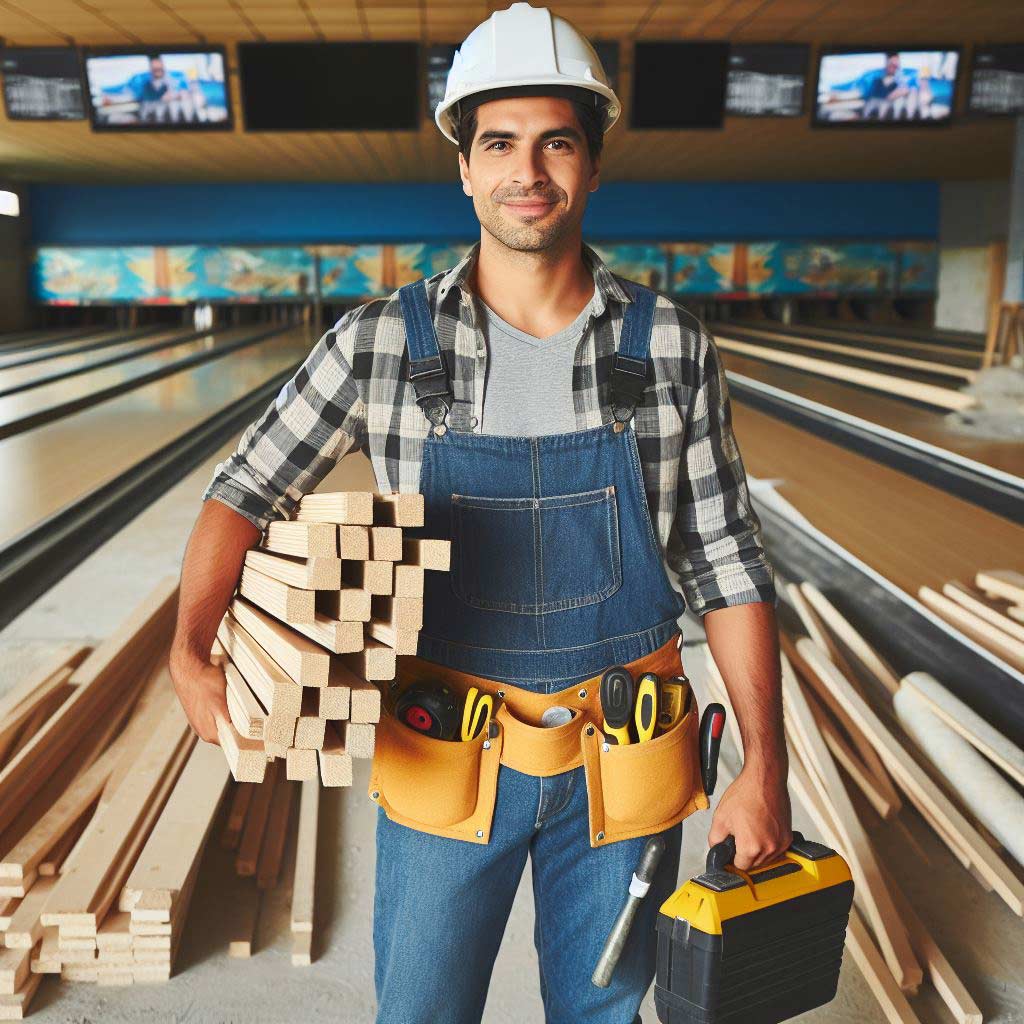Bowling alleys have become an increasingly popular form of entertainment and recreation in recent years. With movie theaters struggling and people looking for more interactive activities to do with family and friends, bowling alleys are an attractive business venture for many entrepreneurs.
If you’re considering building your own bowling alley, one of the first questions you probably have is “How much will it cost?” Building a brand-new bowling alley requires significant upfront capital, but it can also be a very lucrative investment if done right. This is especially true for larger alleys with 12+ lanes, which can accommodate more bowlers and bring in higher revenues.
In this article, we’ll break down the major expenses involved in constructing and equipping a 12-lane bowling alley so you can get an accurate estimate of the total costs.
Whether you’re planning to hire contractors or do some of the work yourself, you’ll need to budget for these main bowling alley construction costs:
Bowling Lane Equipment and Installation
The bowling lanes themselves represent one of the biggest upfront investments when building an alley. Constructing regulation-size lanes means installing specialized synthetic materials, automated pinsetting machines, ball returns, scoring systems, and more.
For a 12-lane bowling alley, you can expect to pay anywhere from $100,000 to $160,000 just for the lane equipment and professional installation.
This factors in synthetic maple or urethane bowling lanes ($7,000-$12,000 per lane), computerized scoring systems ($12,000-$20,000 total), automatic pinsetters ($15,000-$25,000 per lane), ball returns, lane conditioning/cleaning equipment, bumpers, racks, approach area construction, and labor for proper installation.
Hiring experienced contractors for lane installation is highly recommended, as the precision and lane calibration required makes DIY installation extremely difficult. Proper lane installation also ensures minimized maintenance costs down the road.
Interior Construction
After getting the lanes set up, the next major cost is actually constructing the interior space of the bowling alley itself. This includes building the floor foundation and installing of essential utilities like electricity and plumbing, walkways, flooring, walls/partitions, bathrooms, service counters, and more.
For a 12-lane bowling alley spanning at least 7,500 square feet, interior construction costs can easily exceed $200,000. The demands of an active bowling alley require durable surfacing, extra power sources, proper ventilation, and temperature control, acoustic paneling for noise, and specialized lighting.
Factor in another $30,000-$50,000 for permits, contractors’ fees, materials, and professional labor. Be sure to factor in contingency costs for any structural changes or unexpected issues.
Comfortable Seating Area
You can’t have a bowling alley without an inviting seating area for guests to relax, eat, and socialize. Budget several thousand dollars for durable tables, chairs, and booths to accommodate your bowling alley’s guest capacity.
For a 12-lane alley, you may need seating for 60+ people. Quality restaurant-grade seating can cost $100-$300 per chair, and $300-$600+ per table/booth. With additional bar stool seating, expect a total of $15,000-$25,000 for a comfortable, spacious seating area.
Food & Drink Service Equipment
The right kitchen and bar equipment allows you to offer food and drink service to create extra revenue sources. A basic bowling alley kitchen will need fryers, grills, ovens, refrigerators, freezers, ice machines, mixers, and more.
For a full kitchen and bar to service a 12-lane bowling alley, you’ll likely need around $50,000-$75,000 in commercial cooking and bartending equipment.
Factor in any needed venting, grease traps, liquor licenses, and small wares too. Having quality equipment ensures you can prepare a variety of menu items and beverages.
Arcades, Pool Tables, and Other Amenities
No bowling alley is complete without some gaming attractions to keep customers engaged. Plan for $5,000-$10,000 for just a couple of quality pool tables and accessories. Add in another $20,000-$40,000+ for 10-20 arcade game machines, redemption counters, and entertainment/lounge area furnishings.
The more you can turn your bowling alley into a well-rounded entertainment hub, the more revenue you can generate beyond bowling alone. Offering fun distractions for non-bowlers and activities for guests waiting for lanes can optimize profits.
Ventilation and HVAC System
Proper ventilation and climate control are especially important for active entertainment venues like bowling alleys. All that bowling action produces a lot of humidity, heat, and odors that need venting. A commercial HVAC system also keeps bowlers comfortable and cool.
Installation of industrial exhaust hoods, ductwork, large AC units, and climate control systems can cost $35,000 to $60,000+ for a 12-lane bowling alley. Factor in ongoing maintenance too. This significant expense is unavoidable when constructing a quality bowling alley.
Specialized Lighting
Create just the right ambiance in your bowling alley with specialized lighting choices. Mix bright, functional lighting over the lanes and dimmer mood lighting in lounge areas.
LED lane lighting provides optimal visibility without glare. Add vivid neon signs, disco lights, and blacklights to give your bowling alley visual appeal. Allow $15,000-$25,000 to get professional quality lighting installed for all areas of your 12-lane alley.
Powerful Sound System
A bowling alley needs quality audio to amp up the energy and entertain guests. Invest in a powerful stereo receiver, high-output speakers, overhead access points for music streaming, and acoustic installation.
For a 12-lane bowling alley with adjacent lounge/dining space, you can easily spend $10,000-$15,000 installing a professional quality sound system. The bonus is bowlers will love the immersive experience.
Insurance, Permits, and Contractors
There are always peripheral construction costs to account for like contractors, licenses, inspections, and specialized insurance. General liability and property insurance for a bowling alley cost $4,000-$8,000 annually.
Establishment permits, construction administration fees, and contractor labor can add another $15,000-$25,000+. Be sure to get quotes specific to constructing a bowling alley in your area.
Total Costs for Building a 12-Lane Bowling Alley
After adding up the expenses across all the above categories, the total costs involved in constructing and equipping a brand-new 12-lane bowling alley generally fall between $500,000 and $800,000.
However, there are certainly ways to reduce costs with more basic amenities, buying used equipment, or taking on some construction work yourself (within permit allowances). Operating on the lower end of the budget range is advisable for first-time owners.
Here is a recap of typical 12-lane bowling alley construction costs:
- Bowling Lanes & Installation – $100,000 to $160,000
- Interior Construction – $200,000+
- Seating/Furnishings – $15,000 to $25,000
- Kitchen & Bar Equipment – $50,000 to $75,000
- Arcades/Billiards/Amenities – $20,000 to $40,000+
- HVAC & Ventilation – $35,000 to $60,000+
- Lighting – $15,000 to $25,000
- Sound System – $10,000 to $15,000
- Permits, Insurance, Contractors – $15,000 to $25,000
- Total Estimate for 12 Lane Alley: $500,000 to $800,000
Keep in mind this covers constructing a bowling alley from the ground up according to industry standards. Purchasing an existing bowling alley can cost considerably less depending on the age and condition of the lanes and amenities.
Is a Bowling Alley Profitable?
While nearly $1 million may seem like a hefty price tag, a professionally built 12-lane bowling alley can bring in sizable revenues when operated properly.
According to industry data, a modern 12-lane bowling alley can generate $700,000 to $1.5 million in gross annual revenues or more. With leagues, events, food/beverage, and amusement sales, the business can deliver strong returns on investment.
A premium bowling experience, great customer service, fun events, and smart management are key to maximizing your bowling alley’s profit potential. Having an accurate construction budget helps you target the ideal financing and opening timeline.
Ready to Start Building Your Bowling Alley?
Constructing a regulation 12-lane bowling alley requires careful planning, quality materials, and skilled professional contractors. However, the substantial upfront investment can ultimately result in an exciting, profitable bowling entertainment center.
We hope this overview gives you a better idea of typical bowling alley construction costs and considerations. The fun of owning your own alley comes after getting through the complex construction process.
With accurate budgeting and smart management, you can make your dream of opening a top-rated bowling alley a success. Strike up those bowling pins and get ready for family entertainment, full-service dining, and major profits ahead!
Frequently Asked Questions
How profitable are bowling alleys?
Bowling alleys can be highly profitable businesses when run efficiently. Well-managed alleys with 12+ lanes can generate $700,000 to $1.5 million or more in annual gross revenues through bowling fees, equipment rentals, leagues, food & drink sales, and other offerings. Profit margins range from 10-35% before taxes/expenses. Maximizing your alley’s profitability requires providing a quality guest experience, fun events, leagues, pro shops, and more.
How much space do I need to build a bowling alley?
A 12-lane bowling alley needs approximately 7,500+ square feet of space. This includes lanes (60 feet long each), seating area, counter space, kitchen, bathrooms, etc. Ideally, have a space of at least 8,000 square feet and a ceiling height of 12+ feet to accommodate all the necessary bowling alley features comfortably. Having room for future expansion is also recommended.
How do I start a bowling alley business?
The key steps to starting a bowling alley business include: researching licensing/permits, finding a suitable location, buying quality equipment, designing the layout, hiring contractors for construction, establishing operations like leagues and pro shop, hiring staff, investing in marketing, purchasing insurance, understanding finances/projections, and more. Getting professional advice for bowling alley development is highly recommended.
Can you make a bowling alley at home?
It’s very difficult and inadvisable to build a real bowling alley at home. Constructing regulation lanes requires specialized materials, machinery, precision installation, and massive space. Most homeowners don’t have the capacity or permits to safely and effectively create a homemade bowling alley. While mini bowling lanes exist, they don’t replicate the actual bowling alley experience.
Are bowling alleys good investments?
Bowling alleys can provide excellent returns on investment. With the capacity for consistent league bowling, walk-in customers, events, food & drink sales, and more, bowling alleys offer stable, long-term profit potential. However, the substantial $500K+ construction investment means having ample financing and a long runway to profitability. Proper management and marketing are key to maximizing ROI.
Is running a bowling alley profitable?
Running a bowling alley can be very profitable if managed well. Successful bowling alley owners optimize profits by promoting leagues, hosting events, offering quality food/beverages, providing great customer service, controlling costs, keeping equipment maintained, ensuring appealing facilities, retaining experienced staff, and more. Attention to business operations is vital.
Does a bowling alley add value to your home?
Adding a regulation-size bowling alley requires major renovations unlikely to boost overall home value. Few homeowners want 12+ lanes taking up home space. However, smaller-scale built-in bowling lanes could add some novelty value. A home’s location, layout, condition, and comparable sales are bigger factors for property value assessments.
Why are bowling lanes oiled?
Bowling lanes are oiled to protect the wood surface and enable proper ball motion. The oil applied in precise patterns helps guide the ball towards the pocket. More oil increases skid; less oil increases hook. Proper lane oiling provides bowlers with consistent rolling conditions. Lanes are re-oiled after each group.
How do you build an outdoor bowling alley?
To build an outdoor bowling alley, install level artificial turf or composite lane surfaces suited for weather exposure. Ensure proper drainage. Install catch pits instead of hard pin decks. Use portable lighting and scoring. Weatherproof balls/pins. Build a canopy for shelter. Outdoor lanes require heavy ongoing maintenance. Investing in durable outdoor equipment is a must.





